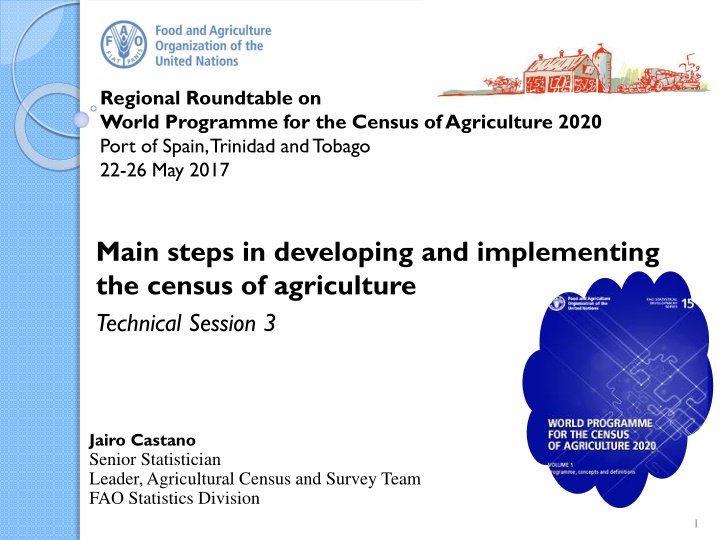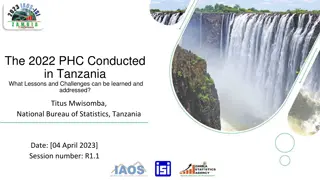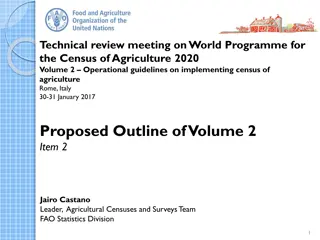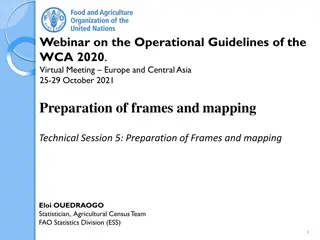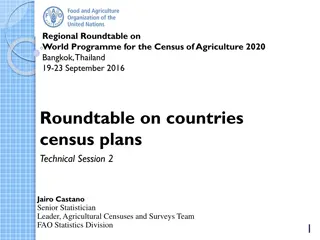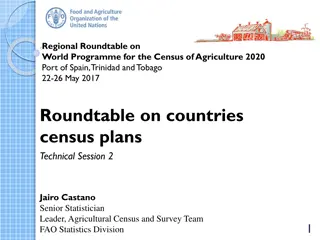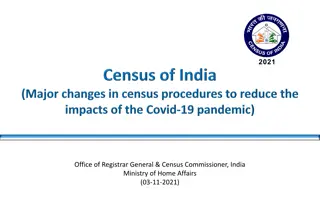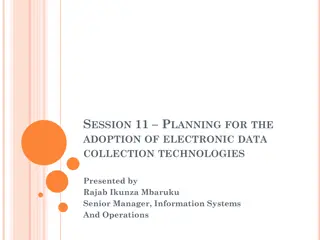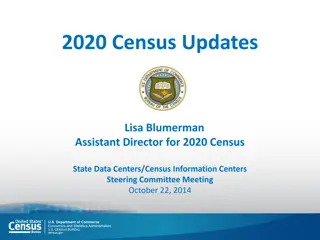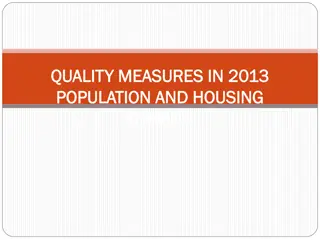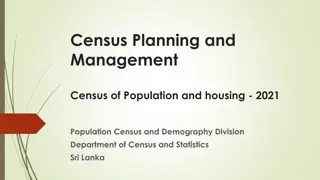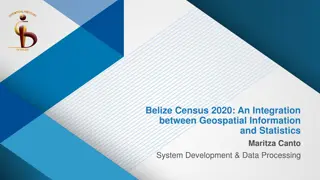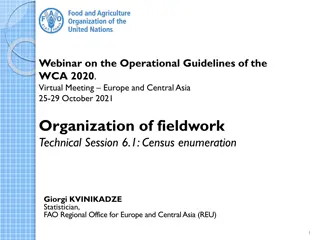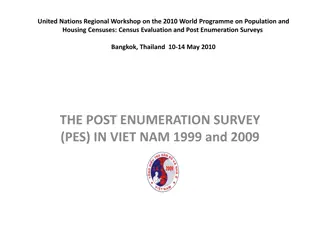Steps in Developing and Implementing Agricultural Census
The process of organizing and executing an agricultural census involves a series of critical steps, from planning and preparation to data processing and archiving. Key activities include identifying the role of the census, developing work plans, defining methodologies, recruiting staff, conducting field operations, and analyzing results.
Download Presentation

Please find below an Image/Link to download the presentation.
The content on the website is provided AS IS for your information and personal use only. It may not be sold, licensed, or shared on other websites without obtaining consent from the author.If you encounter any issues during the download, it is possible that the publisher has removed the file from their server.
You are allowed to download the files provided on this website for personal or commercial use, subject to the condition that they are used lawfully. All files are the property of their respective owners.
The content on the website is provided AS IS for your information and personal use only. It may not be sold, licensed, or shared on other websites without obtaining consent from the author.
E N D
Presentation Transcript
Regional Roundtable on World Programme for the Census of Agriculture 2020 Port of Spain, Trinidad and Tobago 22-26 May 2017 Main steps in developing and implementing the census of agriculture Technical Session 3 Jairo Castano Senior Statistician Leader, Agricultural Census and Survey Team FAO Statistics Division 1
Contents: Steps related to planning and the preparation of the agricultural census (AC) Census enumeration Steps related to Post-enumeration phase 2
Steps in developing and conducting the AC Identify the role of the AC as a component of the system of integrated agricultural censuses and surveys Develop a work plan and budget for developing and carrying out the census Determine the overall strategy for and objectives of the AC Define the methodology Create the Agricultural Census Office and recruit the necessary staff Develop and implement the census publicity campaign Prepare census legislation, if required Design data quality assurance framework Design and test the computer processing system, including data entry, editing and tabulation Develop the tabulation plan Prepare frames and mapping Design and test questionnaires Develop the field system (including monitoring system); recruit and train field staff Census enumeration Post enumeration survey (PES) Prepare field instruction manuals Analysis and prepare census reports, disseminate and publicize results Reconcile the data from the system of current statistics with the census data Data processing, tabulation and archiving 3
Identify the role of the AC as a component of the system of integrated agricultural censuses and surveys The census of agriculture must not be carried out in isolation but as a component of an integrated system of agricultural censuses and surveys Development of the system of agricultural censuses and surveys within the National Statistical System (NSS), in line with the National Strategy for the Development of Statistics (NSDS) Planning and development of a comprehensive multi-year census and survey programme consultation with users, ensuring efficient and balanced use of available resources and avoiding duplication of statistical activities or the release of conflicting statistics prepared in close 4
Define the specific objectives of the AC and determine the overall strategy to implement it Specific objectives of the census of agriculture - to provide key data (mainly on the structure of agriculture): At the national level and for small administrative units/geographic areas (the latter - for all or only for some census items, collected on a complete enumeration basis) To be used as benchmarks for and reconciliation of current agricultural statistics To provide frames for agricultural sampling surveys and data needed for construction of registers of agricultural holders To collect community-level data along withAC holding level data To collect some additional data households (in a widenedAC) To collect specific data requested by Government to fill in some data gaps. on non-agricultural production 5
Define the specific objectives of the AC and determine the overall strategy to implement it (cont d.) Define the overall strategy to implement theAC: Relationship to other censuses Census scope: o Agricultural production industry (production of crop and livestock products) o Forestry and/or aquaculture, and/or capture fisheries activities (usually only associated with the agricultural activity of the holding) Census coverage: o Widened agricultural census o Agricultural holdings in the household sector; o Agricultural holdings in the non-household sector; o Non-agricultural production households in rural areas. o Geographic coverage (full coverage or will be out-of-coverage areas) o Whether or not cut-off thresholds will be used Note: any exclusions from the agricultural census affect not only the results of the AC, but also the surveys that are conducted based on the AC. . Way to implement the census: o Use of administrative data (ADS) as the source for census items o Census phases to collect the data and the census modality, etc. 6
Define the methodology Define the statistical unit(s) Reference period Enumeration period(s) Design collection: o Use ofADS as a source for census data and/or for frames o The establishment of census frame (including listing operation) o Cartography works and Use of maps o Data collection method and use of technology o Sample design (if relevant) o Organisation of field work and census enumeration o Fine-tuning of the methodology instruments) based on pilot census results, etc. Design the Post-enumeration conducted, etc. (along with census Survey (PES), if 7
Develop a work plan and budget for developing and carrying out the census The elaboration of a detailed work plan with the different stages of implementation clearly established. Development of a detailed budget where different components of spending are carefully estimated along with the time-table of expenditures and funding. All census operations including planning, cartography, enumeration, processing, post-enumeration survey, analysis and dissemination should be carefully budgeted from the beginning and efforts made to mobilize the required funds. Planning of the disbursement of funds, including for the remuneration of field staff, in a timely manner. The establishment of a system of monitoring and review of the work plan and the budget and expenditure control. Outsourcing of some census activities under Census Office s (CO) supervision: o Layout and printing of census questionnaires, other census material; reports and other printed dissemination products with census results o Packing and delivery of census materials and equipment o Census mapping o Publicity campaign o Systems development for data collection, processing and dissemination 8
Preparation of census legislation The census legislation is one of the first aspects to be considered when starting to plan the AC, since it constitutes one of the most important instruments for facilitating the census work. If a country lacks an appropriate legal framework for taking periodic censuses, it is important to act early to establish it. In the process of development or updating of the census legislation the subject matter specialists from the census agency should work closely with administrative officers and legal experts in order to ensure the coherence of census acts with other relevant legislation. In general, legal provisions for conducting the census are required for: establishing and regulating primary administrative responsibility, such as designating the office responsible for the census organization; obtaining the necessary funds; determining the general scope and timing of the census; placing a legal obligation upon the respondents to cooperate and provide truthful information; placing a legal obligation upon the census agency/personnel to ensure the confidentiality and protection of the holders information, etc. o o o o o 9
Create the Census Office and develop the Institutional framework The census agency specified in the primary census legislation. Ensuring a strong political support and establishing an efficient between the census agencies is essential. Create the Agricultural Census Office and recruit the necessary staff. Establish a National Census Committee and/or other coordinating boards to oversee and coordinate the AC activities. should be clearly coordination and agency other 10
Develop and implement the census publicity campaign A well-planned publicity campaign is essential to sensitize the public about the purpose of the census of agriculture and, ultimately, to ensure the cooperation of holders to provide complete and accurate data. Development and implementation of communications and publicity strategy o Situation analysis to identifies any particular opportunities or issues that need to be taken into account o Definition of the target audiences (who) o Logos & slogans; messages to be communicated (what) o Communication channels and promotional tools (how) o Implementing the strategy (when) 11
Design data quality assurance framework Quality is a multi-dimensional concept with focus on users needs and satisfaction. A quality assurance framework aims at achieving an appropriate balance between the needs of users, costs, respondent burden, and the various dimensions of quality. The six dimensions of statistical data (or outputs ) quality: o Relevance o Accuracy and reliability o Timeliness and punctuality in disseminating results o Accessibility o Coherence and comparability of statistics o Accessibility and Clarity/Interpretability. Quality management of a census of agriculture should be comprehensive and should cover all activities including planning, development, data collection, processing, evaluation and dissemination of census results. 12
Design data quality assurance framework(cont d) Quality assurance programme (QAP) for the AC The major goal of QAP is to prevent an minimize potential errors at design stage and detect errors as soon as possible so that timely remedial actions can be taken even as the census operations continue. An effective QAP should have the following attributes: o Awell designed system or procedure (which maximizes quality and efficiency); o An effective training program; o A quality control program to ensure the desired level of quality during the course of the census operation; o An evaluation program to measure the accuracy of the census operation and identify areas where future improvements may be made. This may be accomplished by: o Setting standards and using data to improve the process; o Ensuring a better understanding of the overall process by the census staff and their involvement at all phases; o Including quality issues in training programmes; o Quality feedback for each census process for on the spot operational changes when necessary 13
Design data quality assurance framework(cont d) Quality control techniques The success of any QAP depends on: o defining quality standards or requirements o determining appropriate verification techniques o measuring quality o providing for timely feedback from the results of the programme so that effective corrective action may be taken. The main techniques that can be applied during data collection and data processing phase: o Complete verification o Sample verification: acceptance sampling and statistical process control o Post enumeration surveys aimed to assess the quality of the census results. 14
Prepare the AC frame Sources of information for the construction of anAC frame The statistical data and maps of the EAs of the most recent PHC and a list of EAs along with their number of households/housing units. The statistical data and maps of the EAs of the latest AC including a list of EAs with their number of holdings. Statistical farm registers, cadastral and other cartographic materials, other statistical and administrative data sources, which include listings of holdings and/or holders' addresses or their approximate location. It might be necessary, due to lack of reliable information, to prepare the census frame by conducting a listing operation (prior to starting the enumeration of the holdings). 15
Prepare the AC frame (contd) Building the frame To be able to enumerate all holdings a preliminary frame is indispensable. It is made of a set of physical materials (cartographic maps, EA maps, etc.). The minimum data items recommended to be included in the PHC to better identify such households are: (i) Whether the household is engaged in any form of own-account agriculture production (ii) measure of farm size, e.g. area of land & the number of livestock. When PHC does not include specific questions on agriculture, the economic activity status must be considered together with occupation and industry in order to provide an approximation for households involved in own-account agricultural production. Use of farm registers & other statistical/administrative sources to build a frame. Preparation of sampling frames corresponding to each sample selection stage, including detailed mapping to support the field data collection (when sampling is used). The frame requirement is directly related to the type of sampling. Using new technology for building frames, e.g.: GPS, GIS, Remote Sensing. 16
Prepare maps for census field operations Types of maps: topographic sheets, other government maps, satellite images, aerial photography, communication maps, land-use maps, economic maps, city and tourist maps, EAmaps from PHC. The cartographic work should be conducted during the early stages of preparatory census activities. It should start with the inventory of available geospatial information and maps and the evaluation of their suitability forAC purposes. B A large proportion of the cartographic preparations for an AC consists of delineating and identifying the enumerators' areas (EAs) of work. In many countries EA maps are prepared as part of the cartographic work of the Population and Housing Census (PHC). In some countries the cartographic work is conducted for both PHC andAC (e.g. Brazil). Adapting, revising and updating available maps to the census requirements. GIS provides a computer-based design of EAs and significant automation of map production tasks. 17
Develop the tabulation plan The tabulation plan (or programme ): a set of prototypes of statistical tables (dummy tables) prepared to present the main census results, based on the users primary needs. User consultation. The tabulation plan needs to be performed at early stages of census preparation for defining census content and developing the census questionnaires. The preparation of the tabulation plan is an iterative process: census questionnaire and also census methodology are conditioned by the data to be tabulated and, on the other hand, tables depend upon census questions and also census methodology. 18
Design and test questionnaires Census questionnaires working group and user-producers consultations Design and characteristics of the census (holdings ) questionnaires depends on : o the census modality o the type of holding (holdings in the household sector and holdings in the non-household sector) o the method of data collection: paper-based questionnaires (for face-to-face interviews or questionnaires to be mailed) or electronic questionnaires (to be used with CAPI or CASI) Community survey questionnaires Pre-test of questionnaire(s) Pilot census 19
Design and test questionnaires (contd) Questionnaire design: aspects to be taken into account (1) Concepts and definitions used in the questionnaire should be harmonized with those used in the other agricultural statistics programmes The questions, concepts and definitions used in the questionnaire should be easily understood by the holder and the census field staff (the questions should be formulated using, wherever possible, the vocabulary familiar to the holder) Size (length) of the questionnaire Number and types of questionnaires (for different types of holdings, regions when these differ considerably in crop and livestock types and agricultural practices) Sequence of questions Question numbering (important for data processing; to ensure easy reference in manuals, etc.) 20
Design and test questionnaires (contd) Questionnaire design: aspects to be taken into account (2) Paper based questionnaires should be as much pre-coded as possible Size of the print; different type of print for the questions and for notes or instructions to the enumerators Spaces for answers Uniform in style Quality of papers used Shape of the questionnaire Colour of the questionnaire, especially when different census questionnaires are used Availability of the questionnaire in different languages in multilingual countries Instructions to enumerators on the questionnaire 21
Prepare instruction manuals The manuals clearly establish the criteria and procedures to be followed and the work expected to be carried out during the census. These are paramount to ensure quality of work it is essential that they all proceed in the same manner at all levels Manuals for different census stages and categories of staff: o For field staff: enumerators manual; supervisors manual; manual for the provincial coordinators o Training manuals o For listing operation o For key-punchers o Editing manuals o For data cleaners o For the PES, etc. Manuals depending on the format: o Printed manuals, o On-line manuals o Manuals included in the software of data capture devices or o Any combination of them. 22
Table 14.1 Census testing Census testing Questionnaire Testing (pre-tests) Small scale Test the suitability of o the intended census questions, including their formulation and the instructions provided o questionnaire design Test in general public and special population groups Estimate time requirements in enumeration Several rounds may be done Test the data collection methods (e.g. paper, tablets) Pilot Census Larger scale Test the entire census infrastructure Cover one or more sizeable administrative divisions Test all stages of a census: preparatory enumeration, processing and dissemination Best if conditions in the pilot census are close to the conditions present during the actual enumeration Ideally conducted exactly one year before the planned census, if not at least 6 months before Pilot census data do not produce usable substantive data. But analysis of errors from the data may be informative for identifying problems 23
Design and test the computer processing system Considerable time is required to design computer programmes (CPs) for automatic error correction, calculation of sampling errors (when relevant), etc. Initial test of CPs using questionnaires with artificial data. CPs should be tested with data from pre-tests and/or pilot census. error identification, tabulation, CP should be tested, normally by verifying results of both error detection and tabulations for a group of 100-500 questionnaires. Data used for such tests should be tabulated manually to check each item or its classification in the tabulations. Useful to enter erroneous data to test the full range of error detection Tabulation process to be simulated during the test. Data transfer to be tested during the pilot census (for CAPI, CATI, CASI). 24
Develop the field system All questionnaires should be recorded irrespective of the outcome of the interview (completed, no respondent, non-existing, etc.) using a specific code. Rigorous procedure for registration of completed questionnaires should be established to ensure that all agricultural holdings within each enumeration area are accounted for. Set up a monitoring mechanism, including periodic reports with key data regarding census coverage to be provided up to the Census Office HQs in order to take appropriate decisions to solve critical problems. When PAPI is used, special control measures on questionnaires flows are needed : o Completed questionnaires returned by enumerators through supervisors to the designated processing center. Questionnaires should be grouped by geographical areas and properly filed. o During the processing phase: questionnaires are removed from storage for manual coding and editing, data entry and verification. Very rigid control over the flow of questionnaires is needed; periodic reviews in order to detect misplaced questionnaires are useful; o An adequate physical storage space is also required. When CAPI or CASI is used, the activities related to monitoring questionnaires and data entry as well as part of computer editing and coding are done during the enumeration. 25
Census field staff Play a critical role in the conduct of the AC and their duties should be strictly defined It is advisable that the field staff, particularly the supervisors and enumerators, live in the places where they are working, they are familiar with local conditions, are able to communicate easily with holders. Extension assistants or field officers of the Ministry of Agriculture could be a good source for enumerators or supervisors. Usually, not more than 100 to 200 holdings should be assigned to an enumerator, and only 20 to 50 if objective measurements are to be made. Commonly, one supervisor effectively supervises 5 to 10 enumerators Different ways of the organization of enumerators field work: the supervisor gives certain number of EAs to each enumerator - practiced mainly in cases when enumerators with local knowledge are recruited, they can work alone in their EAs a small team of supervisor and enumerators is established - they work together on all EAs assigned to the supervisors; may be reasonable in remote areas with poor transport and communication facilities. 26
Training The organization and delivery of training courses should be included in the planning and budgeting stages of census preparation. Diversity of training programmes/courses: training of trainers, training of: supervisors, enumerators, office staff (e.g. central census office staff, programmers and system analysts, editors, coders, computer operators). Establishment of training venues all around the country. Content and timing of training programmes should be appropriate for the level of personnel to be trained. Developing proper training material for the training classes: training manuals, aids (audio-visual aids) and new multi-media technologies. Selection of appropriate training techniques. Uniform delivery of training in all venues. Training should be: centralized; both theoretical and practical; carefully organized and outlined with an appropriate agenda and time schedule. Training in the use of new technologies as well as the use of training aids. Assessment of trainees. Census personnel should be screened and a final selection made on the basis of a written examination plus an interview. 27
Training (contd) The training procedures can be seen from up to down in a cascade manner: o in first place, high-level census organizers responsible for census organization and administration; o main technical staff at the central census office is charged with the training of trainers for different type of tasks (training for census enumeration and supervision, training of office staff (programmers, coders, data-entry operators or operators of data recording equipment, cartographers); training for using advanced technologies; o the staff so trained will deliver the training courses down to provincial coordinators and office staff; o provincial coordinators so trained have to deliver the training to field supervisors; o field supervisors must train the field enumerators. 28
Census enumeration Rigorous procedure for census enumeration should be established with clear responsibilities of enumerators, supervisors and other field staff. Enumerators are responsible for accurately recording all required information on the agricultural holdings in an assigned area and reporting the progress to their supervisors. Supervisors are responsible for performing quality checks according to the quality assurance plan for the census on the work of enumerators. Monitoring of the census enumeration on a daily basis with the regular collection of the information regardingAC coverage and problems faced. Periodically a report on the outcome of the field data collection should be provided up to the Census Office (CO) in order to take appropriate decisions to solve critical problems Updated instructions and feedback from the CO to field staff regarding census enumeration and post-enumeration activities. 29
Census enumeration (contd) General interview: Enumerators interviewing If possible, appointments should be made in advance For new enumerators it is desirable to spell out possible problems and possible solutions Advance information about the area of enumeration and the people to be interviewed If the area involved is of one cultural group, it is often wise to interview the leaders first to enlist their cooperation and to have them recommend and introduce the enumerator to others in the group. suggestions for preparing the face-to-face should plan their daily routine for 30
Census enumeration (contd) Supervisory work: Identification of EAs Observing interviews during the initial period of an enumerator's work Checking holdings enumerated (using face-to-face interview or by phone): a random selection of holdings in each EA. Checking coverage of the EA: by reconciling the forms in the enumeration record with the maps (when using CAPI - built-in the software). Reviewing the census questionnaires to ensure their completeness, accuracy and consistency. Monitoring the progress of enumeration for the area under their supervision, notably: Number of questionnaires completed Number and percentage of agricultural holdings visited and interviewed Number and percentage of units not interviewed (refusals, non-contact, etc.) Time taken to complete a questionnaire Other data collected by the CO for monitoring purposes. Provide timely information as required by the CO. Collect the completed questionnaires and other documents from enumerators after the end of field enumeration, check them and organize their transmission as required by the CO. 31
Census enumeration (contd) Kit for data collection: For CAPI method: o CAPI device (Tablets, PDA, smartphone) o several paper copies of the questionnaire o Spare battery (could be solar battery) o USB memory stick o Spare SIM card from different provider (optional) For PAPI method: o Paper questionnaires o Instructions manual o Calculator o Pencils o Eraser In addition, for both methods: o GPS device (if not built-in into the CAPI device) o Waterproof bag o Maps of the area assigned (if not incorporated into the device) o Badge for identification o Clip-pad o Torch o First aid kit o Water kit If physical measurements is to be performed (mainly in the supplementary modules in the modular approach): Animal counter, Crop-cutting tools, Scale, et. Other equipment: Raincoat, Rubber boots, Mosquito /snake/spider protection kit 32
Post-enumeration survey (PES) Timing: it should be carried out soon after the census completed. In the cases of the modular and sample/survey modalities, soon after the core modules. New listing: agricultural holdings must be listed again in sampled areas (e.g. EAs). Data collection: on key selected census variables. It should attempt the use of physical measurement of area and actual count of livestock and trees. Reference period: must be the same as for the census enumeration. Objective: to assess the magnitude of non-sampling errors in terms of i) coverage errors and ii) content errors (quality of census data collected). Plan: should be carefully planned and synchronized with the planning of the overallAC activities. Staff: should use the best supervisors and enumerators assigned to other EAs to ensure the best quality of data. Design: a sample conducted independently from the AC enumeration. enumeration is integrated survey to be Further info:Reader is referred to the UN PES Operational Guidelines (2010). 33
Data processing The ICT strategy for the census should be part of the overall AC strategy. Hardware requirements Main characteristics of agricultural census data processing: Large amount of data to be entered in a short time with multi-users and parallel processing mode of servers Large amount of data storage required Relatively simple transactions Relatively large numbers of tables to be prepared Extensive use of raw data files which need to be used simultaneously. Method of data capture chosen by the census office Basic hardware equipment: Many data entry devices (PCs, hand-held devices, depending on data collection mode) Central processor/server and networks Fast, high-resolution graphics printers Number of PCs /handheld devices to be carefully considered Software Preferable to use standard software maintained by the manufacturer with available documentation (to allow for data portability) o o o o 34
Data processing (contd) Data coding Data entry. Methods: Manual Optical scanning Hand-held device CASI and CATI. Data editing and imputation Manual Automated Validation Tabulation Calculation of sampling error and additional data analysis. 35
Data processing (contd) Examples of data scanning and computer assisted systems use for WCA2010 round (FAO, Metadata reports: http://www.fao.org/economic/ess/ess-wca/en/ ) TECHNOLOGY Country Optical character recognition (OCR) Albania, Czech Republic, Greece, Ireland, Malawi, Norway, Philippines, Sweden Intelligent recognition (ICR) character Tanzania, Canada, Cook Island Argentina, Colombia, Cote d Ivoire, Finland, France, French Guyana, Iran, Jordan, Martinique, Mozambique, Slovenia, Thailand, Venezuela CAPI Lithuania, Malta, PDA Mexico, Brazil Australia, Austria, Canada, Estonia, Finland, Iceland, Italy, Latvia, The Netherlands, Poland, Spain, Sweden, USA CAWI, CATI, CAPI combined 36
Archiving Like other data, census data can hold cultural and institutional value far into the future. It is important to take adequate measures to physically secure census data. Data types include: census microdata, final published aggregate data, transitory data file, unstructured data (documentation, record of decision, work plan, budget, manuals, questionnaires, etc.). These data types can be archived and may have different archiving, retention periods and metadata requirements. Digital data must be actively maintained over time to ensure reuse. o Backup copies of data. o Guarding against hardware and software obsolescence, such as outmoded floppy disks and unreadable file formats, as well as physical threats, such as natural disasters, theft or sabotage. 37
Analysis, preparation of census reports and dissemination Designing the dissemination plan during census preparation Preparation of census reports: o On preliminary results o On final results o On quality evaluation of census results (including results of PES) o Analytical/Thematic reports o Technical report Preparation of other census products: o Brochures and flyers o Atlases and other geographic products Methods and tools for dissemination Providing access to census databases Providing public access to microdata Dissemination workshops 38
Reconcile the data from the system of current statistics with the census data 39
